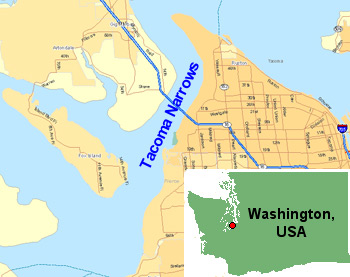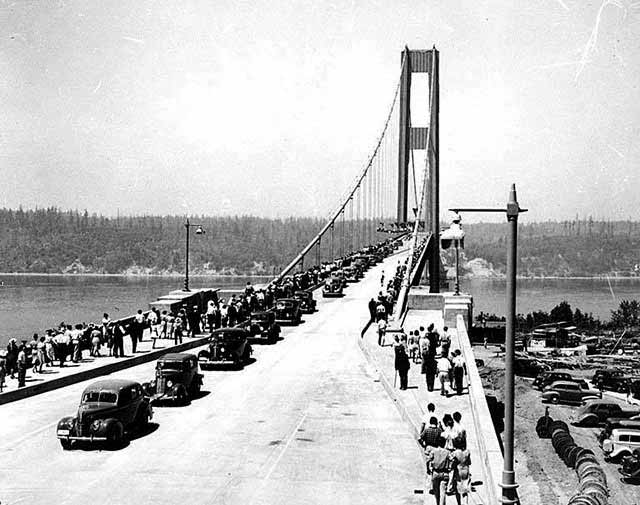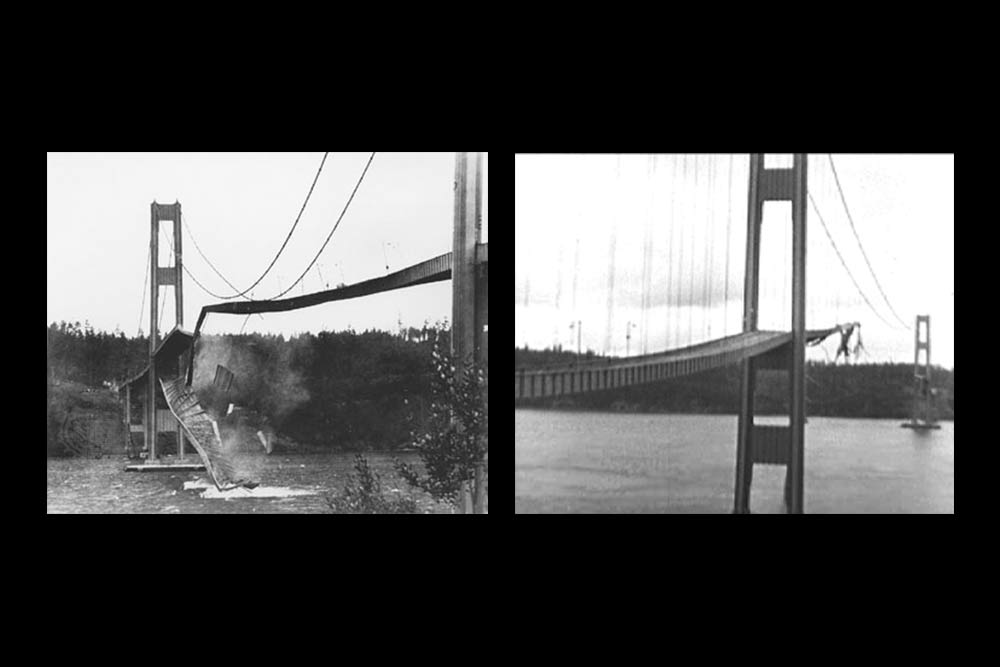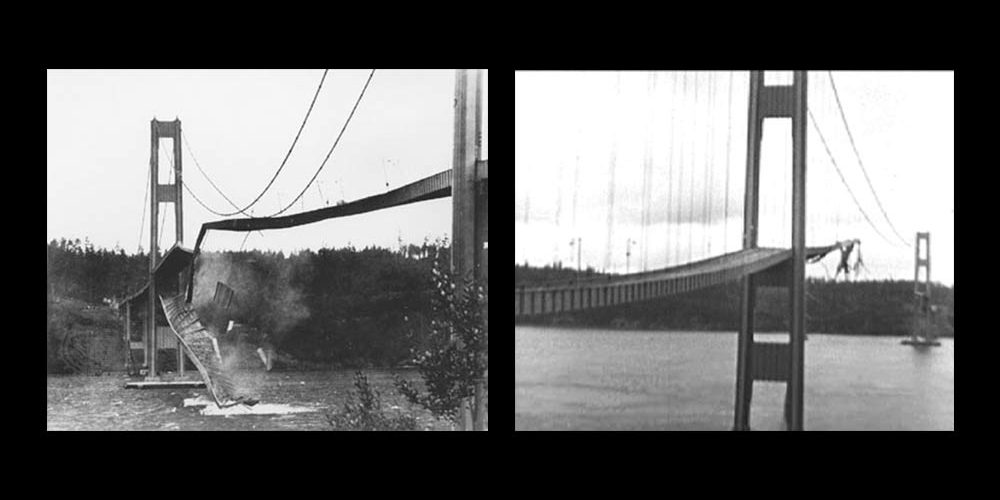It’s among the most famous film clips in history, important enough to have been selected for preservation by the National Film Registry of the Library of Congress. It shows a man on a bridge trying to save his dog during a major windstorm. (Spoiler alert: The man fails in his quest to get the dog out of his car and rescue him from the bridge.) It was filmed by a camera shop owner and early home movie enthusiast named Barney Elliott.
So, what makes the film so special?
The ending captures the epic collapse of the original Tacoma Narrows Bridge on Nov. 7, 1940. The two-and-a-half-minute clip shows, step by step, one of the most dramatic structural failures in history. If you haven’t seen it, you can check it out here:
https://www.youtube.com/watch?v=nFzu6CNtqec
Even people who have viewed the short home movie or studied this collapse aren’t aware of the entire story behind it. It’s a dramatic one that could make a fascinating full-length feature film, either a comedy of errors — or tale of hubris.
The setup
 There was an interest in building a bridge across the Puget Sound between Tacoma, Washington, and the Kitsap peninsula as far back as 1889. (Tacoma was incorporated as a city just about a decade earlier and had a population of 36,000 people.) The Northern Pacific Railway wanted to speed service between the two locations and proposed a trestle bridge. The plan was rejected because the span was too long and the weather at the site too extreme for a trestle structure to hold up.
There was an interest in building a bridge across the Puget Sound between Tacoma, Washington, and the Kitsap peninsula as far back as 1889. (Tacoma was incorporated as a city just about a decade earlier and had a population of 36,000 people.) The Northern Pacific Railway wanted to speed service between the two locations and proposed a trestle bridge. The plan was rejected because the span was too long and the weather at the site too extreme for a trestle structure to hold up.
Further attempts to build a bridge across the sound were put on hold until the 1920s, when funding was appropriated to study different bridge design options. Experts decided that a suspension bridge would be the best solution for the challenging location.
A very sturdy design was recommended because experts believed it would hold up against the strong winds in the sound. Preliminary plans called for a set of 25-foot-deep trusses to support the roadway and stiffen it. However, there were concerns about the cost of building such a highly fortified bridge.
Leon Moisseiff, a famous New-York-based bridge designer who was known for his work on the Golden Gate Bridge, stepped in with a plan for a lower-cost bridge. He based it on a ground-breaking paper he had published along with Frederick Lienhard, an engineer from New York. The paper advanced a novel concept of elastic distribution.
The elastic distribution theory advanced by Moisseiff and Lienhard pushed beyond an earlier deflection theory developed by Josef Melan, an Austrian engineer. They proposed that stiffening the main cables through the suspenders on bridges could absorb up to one-half of the wind pressure pushing against the structure. They explained that this energy could then be transmitted to the anchorages and towers and absorbed by them.
Based on this theory, Moisseiff proposed a bridge with a set of eight-foot-deep plate girders rather than the far deeper 25-foot trusses that were part of the original design. Officials decided to move ahead with Moisseiff’s concept because it significantly reduced costs. It would also result in a narrower, sleeker, more elegant, and less intrusive structure crossing the prominent natural location.
Construction of the bridge began on Sept. 27, 1938. It took only nineteen months to complete. When it was done, it was the third-longest suspension bridge in the world, behind the George Washington Bridge in New York and Moisseiff’s Golden Gate Bridge in San Francisco.

Drama on the construction site
Very quickly, construction workers discovered a major issue with the bridge: It shook uncontrollably on windy days, which are very common in the Puget Sound.
In mild to moderate winds, each half of the bridge would rise and fall several feet every four or five seconds. This resulted in extreme rocking that alternately lifted each side of the roadbed, creating a see-saw-like motion. It got so bad, the people building the bridge started referring to it as “Galloping Gertie.”
What caused the motion? Moisseiff’s bridge had only two lanes and the roadway was only 39 feet wide. This is remarkably narrow, especially when considering the length of the bridge (approximately 2,800 feet). The eight-foot plate girders made the roadway shallow as well. The relative smallness of the deck and its limited rigidity made it easy for winds to move it.
Attempts to stop Gertie from galloping
Engineers couldn’t ignore the shaking on the bridge. Rather than abandoning the seriously flawed structure and building a new one, they took several steps to try to fix it. These included:
- Using cables to tie the plate girders to fifty-ton concrete blocks on the shore to stabilize the deck. This solution didn’t work. The cables snapped soon after they were installed.
- Adding a pair of inclined cable stays that connected the main cables of the bridge to its deck at the center of the structure. These did little or nothing to help reduce the shaking.
- Installing hydraulic buffers between the towers and the deck. They were supposed to limit the up-and-down motion. The buffers might have been effective; however, they were damaged while the bridge was being prepared for painting and never went into service.
Despite the shaking, officials decided to open the bridge to traffic on July 1, 1940. They felt confident the structure could absorb the energy from the up-and-down motion.
After the bridge opened, a final attempt was made to get the swaying under control. Members of the engineering department of the University of Washington built a 1:200 scale model of the bridge and used it to conduct wind tunnel tests.
As a result of the tests, the university recommended drilling holes into the lateral girders and other sections of the deck. Their tests showed this would allow wind to blow through them, which would reduce the lifting forces. This option was rejected by local officials because once it was done, it couldn’t be undone. They believed it could permanently damage the bridge.
The university also suggested adding structural components to the deck that would transform its shape into a more aerodynamic, wind-friendly one. Officials planned to move ahead with this plan, but the bridge collapsed before it could be implemented.
The dramatic ending

The Tacoma Narrows Bridge came down on Nov. 7, 1940, just over four months after opening to traffic. The official cause cited for the collapse was aeroelastic flutter. The only life lost was the dog in Barney Elliott’s video, who drowned inside his owner’s car after it tumbled into Puget Sound.
While the bridge had many design flaws and issues, it was the plate girders that officials credited with its ultimate demise. Most similar bridges use open lattice beam trusses to support the roadbed. This allows wind to pass through the structure. The plate girders installed on the Tacoma Narrows Bridge were built out of carbon steel sealed in solid blocks. Because they were solid, wind was forced to pass above and below the roadbed, which led to the up-and-down wave-like shaking.
All bridges are designed to withstand the amount of shaking or flutter that can be expected based on the conditions at their locations. They do this by distributing and absorbing the vibrational energy throughout a structure engineered to be strong enough to handle the forces.
In the case of the Tacoma Narrows Bridge, the cables transferred the energy to the towers and support structures. The 40-plus-mile-per-hour winds the day the bridge came down were so extreme and unrelenting, the vibrational energy became more than the cables were able to absorb.
You can actually see the cables snap in Barney Elliott’s video. As more and more cables broke, the structure could no longer suspend the roadway and it began to crumble into the sound.
Officials also note another factor contributed to the collapse: The winds were unusual that day because they caused the the roadbed to not just rock back and forth but also twist. This resulted in a new form of vibration impacting the structure, one it had never experienced before and that may have speeded its demise.
The sequel

Remnants of the collapsed bridge were salvaged because steel was a particularly rare and valuable commodity during World War II. Somehow, the cable anchorages, tower pedestals, and other foundational elements survived. These elements were reused in a replacement suspension bridge that leveraged a new design more suitable to the extreme conditions of the site.
The new Tacoma Narrows Bridge was designed to be stronger than the original one, while allowing extreme Puget Sound winds to pass through it. Because of the difficulties involved in working through World War II, it took until 1950 for the replacement structure to open.
The 1950 bridge continues to carry traffic across the Puget Sound. Traffic volume in the area increased over the years, so a second, parallel bridge was added next to it in 2007. The new bridge handles eastbound traffic, while the older one carries vehicles westbound. It’s amazing that pieces of the original “Galloping Gertie” still survive.
Epilogue
The collapse of the original Tacoma Narrows Bridge was a costly, epic engineering failure. Still, it has served a valuable purpose in that it has taught generations of bridge designers and engineers valuable lessons on how to prevent similar disasters. In fact, most engineering students today still study Barney Elliott’s film of the collapse as part of their formal training.
It could help them avoid Moisseiff’s fate. Despite his many successes, he will always be remembered as the man responsible for designing Galloping Gertie.

